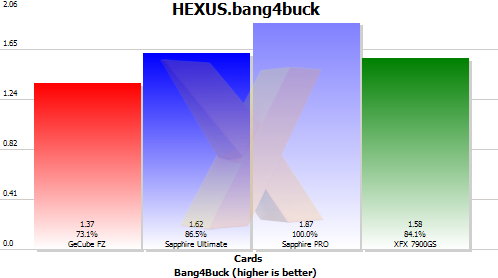HEXUS.bang4buck and overclocking
HEXUS.bang4buck
In a rough-and-ready assessment of the card's bang per buck, we've aggregated the average 1280x1024 4xAA 8xAF framerates for the three games and listed the cards' price. There are more provisos than I care to shake a stick at. We could have chosen three different games, the cards' prices could have been derived from other sources and pricing is such that it can fluctuate daily. However, to reiterate, the graph below highlights a metric that should only be used as a yardstick for evaluating comparative performance with price factored in. Other architectural benefits are not covered, obviously.| Card | Gecube FZ Cool X1950 PRO 512MB | Sapphire X1950 Pro ULTIMATE 256MB | Sapphire X1950 Pro 256MB | XFX Geforce 7900GS 256MB GDDR3 Extreme Edition |
|---|---|---|---|---|
| Actual aggregate marks at 1280x1024 4xAA 8xAF | 272.08 | 261.64 | 253.91 | 251.52 |
| Aggregate marks, normalised*, at 1280x1024/th> | 225.5 | 220.6 | 217 | 215.75 |
| Price - at the time of writing | £164.99 | £136.29 | £115.86 | £137.01 |
| Acceptable framerate (60FPS average) at 1280x1024 4xAA 8xAF | Yes | Yes | Yes | Yes |
* - The normalisation refers to taking playable framerates, which we consider to be an average of 60FPS in all games, into account. Should a card benchmark at over 60FPS in any one game, the extra FPS counts as half. Similarly, should a card benchmark lower, say at 40FPS, we deduct half the difference from its average framerate and the desired 60FPS, giving it a bang4buck score of 30 marks. The minimum framerate, then, can be 20FPS, as that will score 0.
As an example, should a card score 120FPS we count it as 90FPS (120 - (120-60)/2) as only half the framerate above 60FPS is counted for the bang4buck. Similarly, should it score 30FPS we count it as only 15FPS (30 + (30-60)/2).
The reasoning behind such calculation lies with playable framerates. Should card A score 110FPS in a benchmark and card B 160, then card B would normally receive an extra 50 marks in our bang4buck assessment, even though both cards produce perfectly playable framerates and anything above 60FPS is a bonus and not a necessity for most. However, the bang4buck total would be identical if in another benchmark card A scored a smooth 70FPS and card B an unplayable 20FPS, as both aggregate to 180 marks, yet the games-playing experience would be vastly different. You would, on balance, say that card A was better because it ran smoothly in both games. In our revised aggregation, card A would receive 150 marks (85 + 65) and card B 110 (110 + 0).
In effect, we're including a desired average framerate, in this case 60, and penalising lower performance whilst giving higher-than 60FPS framerates half as much credit as the framerate up to 60FPS. If that doesn't make sense or you have issue with it, please hit the HEXUS community.

The graph highlights the normalised marks divided by current price. The GeCube FZ offers poor value for money when compared against the three other cards. As you can see, its extra performance doesn’t make up for the additional outlay. Of course, this graph simply highlights performance and price. Non-3D-related features aren't covered.
Overclocking
Out of the box the FZ Cool isn’t overclocked. As ever, we pushed as much as performance as we could from the card during testing. We did manage to get a fairly impressive 648MHz from the core, up from 574MHz; we also cranked the memory as high as it would go on ATI’s Overdrive tool - to an effective 1.593GHz, from 1.377GHz.
Our biggest limitation here was the software. Unfortunately, the version of ATI Tool we used caused the system to hang, which forced us to use ATI’s Overdrive tool instead. Overdrive tops out at 1.593GHz – which brought an abrupt end to out overclocking tests. This is a pity since we didn’t even get the GDDR3 memory up to the 1.6GHz at which it is rated. With better tools it’s likely that the card’s memory would overclock considerably higher. We did reach the maximum value available on the GPU core, though.
That said, GeCube reckons that 681/1620 should be possible with its TEC-cooled X1950 Pro. That’s a little adventurous and misleading in our opinion.









